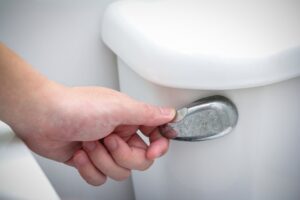Perhaps this sounds familiar. You flush the toilet. After the bowl empties, it begins to refill. But even after you’ve finished washing and drying your hands, the sound of running water hasn’t stopped. You wait another minute or two, but it’s still going. What in the world is wrong? And what can you do about it?
A continuously running toilet is a very common plumbing problem, and because it is wasting a lot of water, you shouldn’t ignore it. We’ll cover the most common reasons for toilets to run after flushing, what you can do about it yourself, and when you should get professional plumbing help.
Float and Chain
Inside your toilet tank, there is a float that registers the depth of the water. When it reaches the top level, the toilet stops running. If the float is broken, it may not rise, so it never indicates that the tank is full. A broken float should be replaced by a plumber.
However, there is another reason that floats sometimes fail to rise, even if they’re in perfect condition. The float is held by a chain, which allows it to rise to the proper level. If that chain becomes tangled or caught on something, it may not be allowing the float to rise. You can check for this yourself and if that’s the problem, it’s a very easy fix. Just make sure it can extend to its full length so the float will reach the top.
Flush Valve
This part is at the bottom of the tank. If it’s loose or leaky, the running might stop if you jiggle the flush handle. This does not truly address the root of the problem, though. It will keep happening until you have the flush valve replaced by a plumber in Stoneham, MA.
Refill Tube
This is the source of the water that’s refilling your toilet’s tank. It should be above the surface of the water. If it is broken or damaged, it could dip below the water level. This will allow the water to continue running as though the tank has not been filled. A plumber can replace this part and get your toilet working properly again.
Gaskets
Below the tank and above the toilet bowl, there are gaskets that form a seal between the two. Deteriorated gaskets can happen when toilets are quite old. One sign that this is the source of the problem is if there is leakage outside the toilet, with water pooling around the base.
If this occurs, you need to address it immediately. That water can cause a lot of damage, seeping into your subfloor and weakening the structure of your house as well as creating an ideal environment for mold to grow. This might be a good time to consider replacing the whole toilet, especially since new toilets are much more efficient and will lower your water bills.
Reach out to Cooling Unlimited, Inc. for all your plumbing needs.


